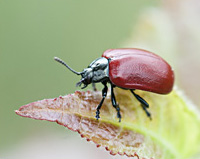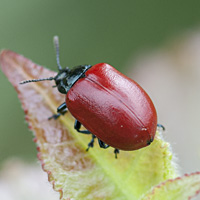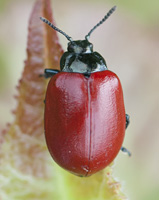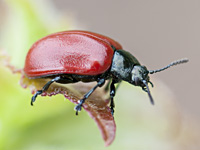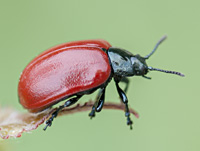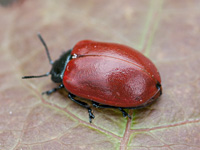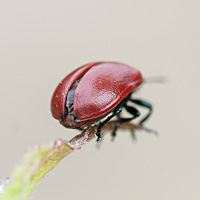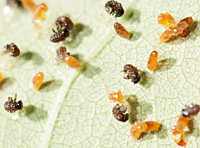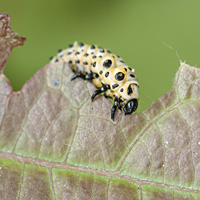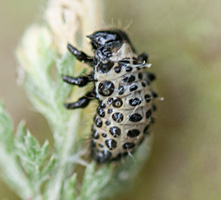[All pictures of garden wildlife on this page are thumbnails. Click on any thumbnail for a large format to be displayed.]

Poplar Leaf Beetle (Chrysomela populi)
| Taxonomy | ||||||
|---|---|---|---|---|---|---|
| Kingdom: | Phylum: | Class: | Order: | Family: | Genus: | Species: |
| Animalia | Arthropoda | Insecta | Coleoptera | Chrysomelidae | Chrysomela | C.populi |
This beautiful beetle belongs to the family of Leaf Beetles (Chrysomelidae). There are over 25 thousand species of Chrysomelidae in the world. Many of them rank among serious agricultural and forest pests.
Poplar Leaf Beetle is also known as Red Poplar Leaf Beetle or Melastoma populi. Its length is 10-12mm. The distinguishable features to pay attention to are bright red wings (elytre), rather broad shoulders, metallic black and greenish head and pronotum and a black dot at the tip of the wings. The antennae are black formed by 11 segments. The larvae are white with black dots geometrically spread over the whole body supported by 3 pairs of black legs. They are extremely greedy and devastate trees much faster than the adults.
This beetle occurs from Europe to Asia, Japan included. It follows the same ecological distribution as the poplar (Populus) and the willow (Salix) to which is associated. It can usually be found on or near these trees as it feeds on their leaves.
The beetles of C. populi survive winter in various shelters especially hidden under leaves or in tree bark. When the temperature rises to 12 to 13C in April/May, they come out from hibernation shelters and soon appear on host species. The adults reproduce in spring. Females lay red-orange elongated eggs of 1,8mm long on top of the poplar leaves. These eggs become darker when larva develops inside. Larvae metamorphose within a week. There are 2-3 generations per year but on rare occasions even as many as 4-5.
The genus name 'Chrysomela' is based on Greek words 'chrysos' meaning gold and 'melas' meaning black. The species' name 'Populi' comes from Latin word 'populus' meaning poplar, obviously pointing to the beetle's preference for host plant and source of food.

© Copyright 1998-2024 gardensafari.net (Hania Berdys)

 English / engels
English / engels  Dutch / nederlands
Dutch / nederlands